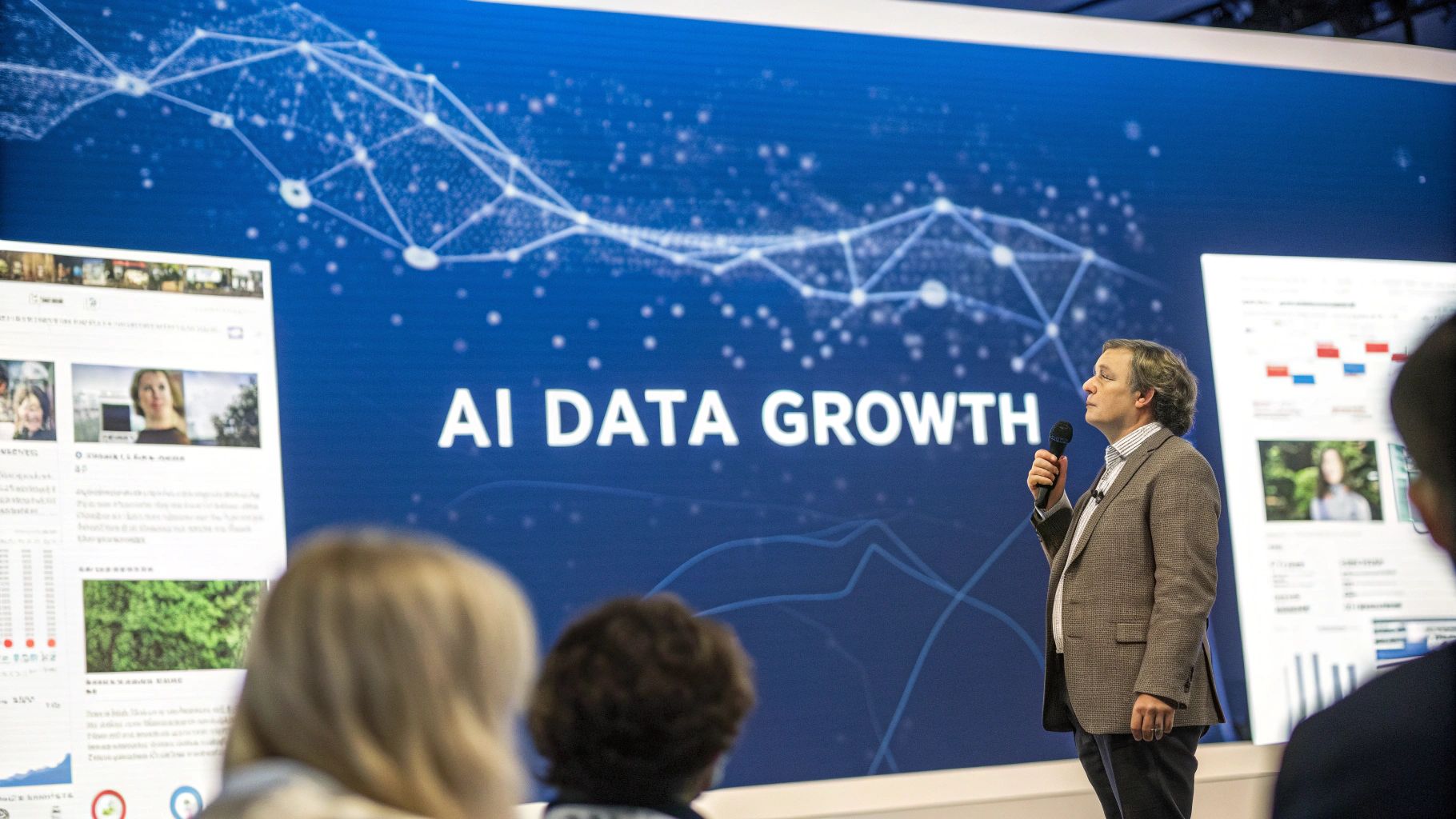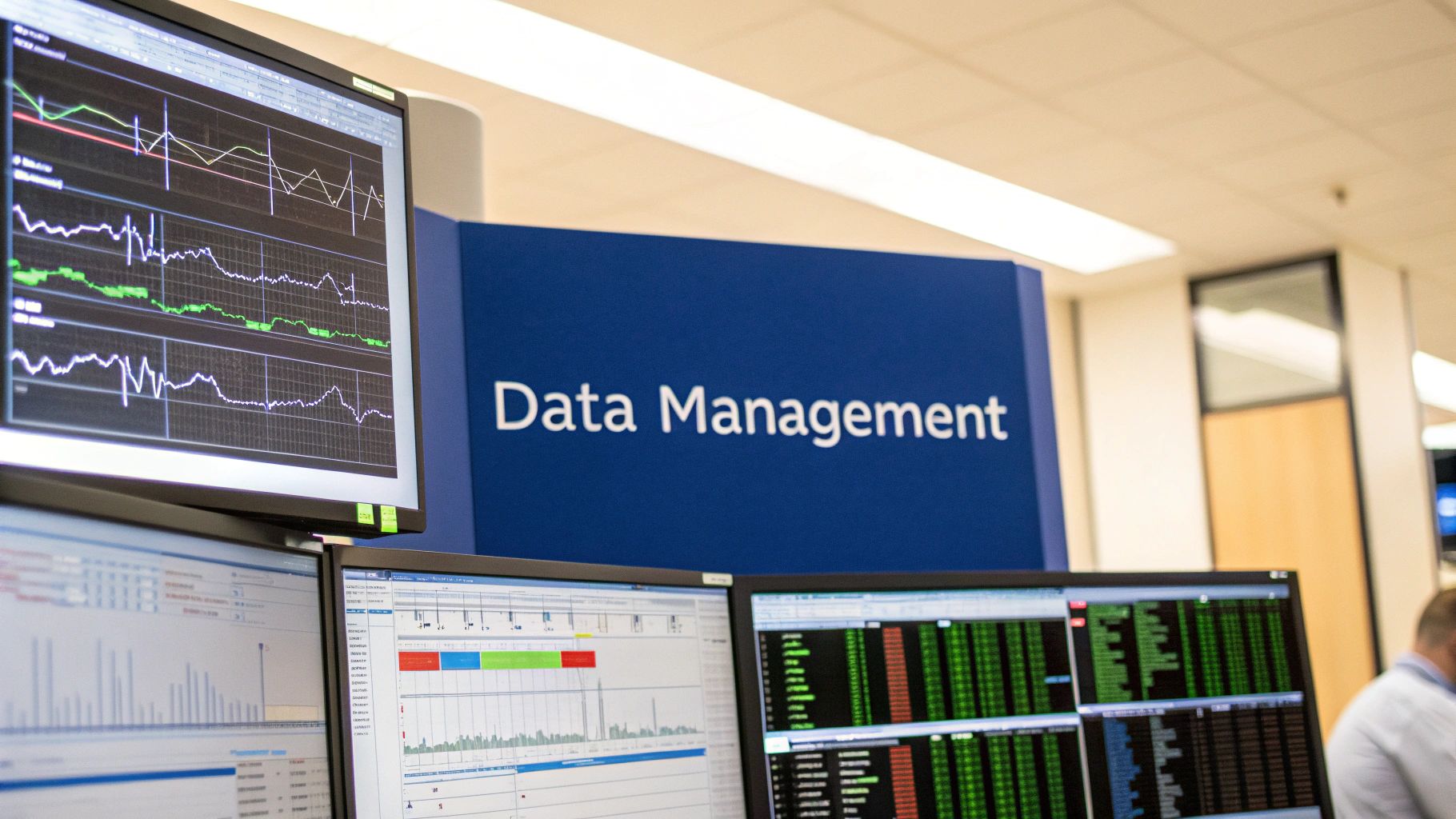Picture a master chef who can instantly taste every ingredient in a sprawling pantry and knows, instinctively, the perfect dish to create. That's essentially what intelligent data and AI services do for your business. They take all your raw, scattered information and turn it into a clear recipe for success.
What are Intelligent Data and AI Services?
At their heart, these services mark a massive shift from just hoarding data to actually understanding and acting on it. Traditional data is like a library packed with books but no catalogue system. All the information is technically there, but finding what you need is a nightmare. Intelligent data and AI services are the expert librarian who’s read every book, gets the connections between them, and can hand you the exact piece of knowledge you need, right when you need it.
The process uses artificial intelligence to dig through huge volumes of information, spot patterns, flag anomalies, and make predictions about what's coming next. It’s not just about getting robots to do tasks; it’s about making human intelligence even more powerful. To get a good handle on this, it's helpful to first understand what AI in business means and how it really fuels growth.
The Synergy Between Data and Intelligence
Data by itself doesn't do much. It's just sitting there. It’s the AI that breathes life into it, making it "intelligent." This powerful duo is what lets a company stop making decisions based on rearview mirror analysis (what already happened) and start building proactive strategies (predicting what's going to happen).
This connection is built on a few key abilities:
-
Contextual Understanding: AI doesn't just see numbers on a spreadsheet; it understands the story behind them. It knows the difference between a sales dip because of a public holiday and one that signals a worrying market trend.
-
Continuous Learning: These systems never stop learning. They get smarter with every new piece of data they process, refining their accuracy over time, just like a seasoned expert gets better with experience.
-
Actionable Recommendations: The end goal isn't just to show you a chart. It's to suggest what to do next. An intelligent system won't just report that customer engagement is down; it might also recommend specific marketing campaigns to win back those customers.
The real magic of intelligent data and AI services is how they close the gap between knowing something and doing something about it. They deliver the right insights at the right time, giving teams the confidence to make faster, smarter decisions that have a real impact.
Moving Beyond Basic Analytics
This is a huge leap forward from traditional business intelligence (BI), which mostly deals with descriptive analytics, looking at dashboards and reports to see what happened in the past. That's useful, but it's limited.
Intelligent services are all about predictive and prescriptive analytics. For a deeper dive into how these technologies are used, you can explore more articles on artificial intelligence. Instead of just telling you what happened, they forecast what’s likely to happen and suggest the best way to get the results you want. This forward-looking ability is what makes them so special, turning your data from a simple historical record into your most valuable strategic asset.
The Core Technologies Driving AI Services
To really get a handle on intelligent data and AI services, you have to look under the bonnet at the technologies that make it all happen. These aren't just abstract ideas; they're powerful engines that can solve incredibly complex business problems when they work together. Each one has a specific job, but their true power comes out when they're combined.
This is a great visual of how data scientists actually use these core technologies to pull powerful AI insights out of raw data, which ultimately fuels business growth.

As you can see, analysing data effectively through tools like interactive dashboards is at the centre of building the AI-driven strategies that push modern companies forward.
Machine Learning: The Engine of Adaptation
At the heart of almost every AI service is machine learning (ML). The best way to think about it is as a system that learns from experience, just like we do, but on a massive scale. Instead of being programmed with a rigid set of rules for every possible situation, an ML model is trained on huge amounts of data.
From that data, it starts to recognise patterns and builds its own logic to make predictions or decisions. A classic example is an e-commerce platform using ML to analyse your past purchases and what you've browsed. It then predicts what you might want to buy next, creating those "Recommended for You" sections that feel like they were made just for you.
This ability to adapt is what makes ML so potent. It's the technology behind:
-
Spam filters that get progressively better at spotting junk email.
-
Fraud detection systems that can flag unusual transaction patterns in real-time.
-
Demand forecasting tools that help retailers figure out exactly how much product they need to stock.
Natural Language Processing: The Bridge to Human Communication
While ML is a genius with numbers and patterns, Natural Language Processing (NLP) is what helps machines understand and respond to human language. It's the essential bridge that lets us talk to computers using our own words, whether we type them or speak them.
Every time you ask a virtual assistant a question, use a translation app, or chat with a customer service bot, you're seeing NLP in action. The technology breaks down sentences to figure out intent, context, and even the emotion behind the words. This skill unlocks a goldmine of value from unstructured sources like customer reviews, social media comments, and support tickets.
NLP doesn't just read words; it deciphers meaning. This allows intelligent data and AI services to transform qualitative feedback into quantitative insights, giving businesses a direct line into the voice of their customers.
Predictive Analytics: The Crystal Ball for Business Strategy
Predictive analytics takes historical data, statistical algorithms, and ML techniques and uses them to figure out the likelihood of future outcomes. If ML is the engine that learns, predictive analytics is the application that tells you what’s probably coming around the corner. It answers the crucial question: "Based on everything we know, what's most likely to happen next?"
This kind of foresight is incredibly valuable for strategic planning. For example, a logistics company can use predictive analytics to anticipate shipping delays based on weather forecasts and traffic data, letting them reroute shipments before a problem even occurs. This shifts a business from being reactive to proactive, which saves a lot of time and money.
The power of these systems is often amplified when they're running on a solid foundation, which is why understanding the benefits of cloud enablement services is so important for any company looking to scale up its AI efforts.
The demand for these advanced capabilities is growing fast. The Artificial Intelligence market in the Caribbean and the wider Latin America region is expected to hit about USD 265.8 million by 2025. This growth is being fueled by the adoption of technologies like ML and NLP across all sorts of industries.
How AI Services Create Real-World Business Value

The true test of any new technology isn't how complicated it is, but what it actually does for your business. When it comes to intelligent data and AI services, the value is direct and measurable. This isn't about theoretical gains; it's about delivering concrete advantages that can fundamentally change how a company operates and grows.
Think of AI as a catalyst that awakens your dormant data, turning it into one of your most dynamic assets. The result is a more agile and insightful organisation, ready to make smarter decisions faster than ever before.
Boost Day-to-Day Efficiency Through Automation
One of the first places you'll feel the impact of AI is in the automation of routine, repetitive tasks. Think about all the hours your team spends on manual data entry, generating standard reports, or sorting through an endless stream of customer emails. AI is built to handle these high-volume, rules-based jobs with a level of speed and accuracy that's simply not humanly possible.
This isn't about replacing your team; it's about empowering them. By handing off the monotonous work to an AI system, you free up your people to focus on what they do best: thinking strategically, solving complex problems, and building real customer relationships. A great example of this in action is modern Intelligent Process Automation software, which uses AI to untangle and speed up complicated business workflows.
The financial upside is significant. Early adopters of AI-driven automation are already seeing up to 40% lower expenses and cutting their operational costs by 20–50%.
Make Smarter Decisions with Predictive Insights
For decades, business strategy has involved looking at past performance and making an educated guess about the future. Intelligent data and AI services are flipping that model completely on its head. By using sophisticated algorithms to comb through historical data, these systems can spot subtle patterns and forecast future trends with uncanny accuracy.
This gives your business the power to shift from a reactive to a proactive stance. Suddenly, you can:
-
Anticipate customer churn by identifying at-risk behaviours long before a client decides to leave.
-
Forecast inventory needs to avoid costly stockouts or wasteful overstocking.
-
Predict equipment maintenance to schedule repairs and prevent surprise breakdowns.
By looking forward instead of just backward, you can jump on opportunities and sidestep risks before they even fully emerge. This predictive power turns strategic planning from a guessing game into a data-driven science.
Deliver Hyper-Personalized Customer Experiences
Today’s customers don’t just want a good product; they want an experience that feels like it was made just for them. The old one-size-fits-all approach to marketing is dead. AI services make it possible to deliver hyper-personalization at scale by analyzing individual customer data, from browsing habits to purchase history, in real time.
For an e-commerce store, this might mean a website that dynamically rearranges itself to show each visitor the products they’re most likely to buy. For a bank, it could be offering personalized investment advice based on a client's specific financial goals and risk tolerance.
This deep level of personalization builds powerful customer loyalty and has a direct impact on revenue. It's no surprise that 56% of banks are now making personalization their top priority for AI, as it’s a proven way to drive engagement and attract new business.
Uncover New Ways to Grow Revenue
Your data is hiding secrets, including untapped revenue streams you might not even realise are there. AI services are brilliant at sifting through enormous datasets to find hidden connections and emerging market opportunities that a human analyst would almost certainly miss.
This could mean discovering a new customer segment your product is perfect for, identifying a complementary item to bundle with a bestseller, or even creating an entirely new service based on patterns in customer behaviour. By analyzing market trends and your own internal data in tandem, AI can give you a clear roadmap for sustainable growth, helping you not only keep pace with the competition but stay several steps ahead.
To illustrate how this plays out across an organization, here’s a quick look at how different departments can put AI to work.
Key Benefits of AI Services Across Business Functions
|
Business Function |
AI Application |
Primary Benefit |
|---|---|---|
|
Marketing |
Personalized campaign targeting, lead scoring |
Increased Conversion Rates & Higher ROI |
|
Sales |
Predictive sales forecasting, CRM automation |
Shorter Sales Cycles & Improved Accuracy |
|
Customer Support |
AI-powered chatbots, sentiment analysis |
Faster Resolutions & Higher Customer Satisfaction |
|
Operations |
Supply chain optimization, predictive maintenance |
Reduced Downtime & Lower Operational Costs |
|
Finance |
Fraud detection, automated invoice processing |
Enhanced Security & Greater Financial Efficiency |
|
Human Resources |
Automated candidate screening, sentiment analysis |
Better Hiring Decisions & Improved Employee Retention |
Ultimately, intelligent data and AI aren't just siloed tools for one department; they provide a comprehensive lift that improves decision-making, efficiency, and customer value across the entire business.
Real-World AI Success Stories by Industry
It's one thing to talk about the theory behind intelligent data and AI services, but it’s another thing entirely to see them at work. The real magic happens when these complex technologies solve tangible, everyday problems. Across countless industries, businesses are no longer just exploring AI; they're putting it on the front lines to cut costs, find new revenue, and build better relationships with their customers.
These aren't just small tweaks, either. We're seeing fundamental shifts in how entire sectors operate. Let’s look at a few specific examples to see the clear pattern: a common problem, an intelligent solution, and a measurable outcome.
Transforming Retail with Personalized Shopping
Customer loyalty is a constant battle in retail. Take a major online fashion retailer, for example. They were bleeding potential sales from abandoned shopping carts and struggling to get customers to come back. Their one-size-fits-all marketing just wasn't cutting it; it failed to connect with what individual shoppers actually wanted.
Their solution? An AI-powered recommendation engine. This system has to work analysing real-time data for every single visitor, looking at things like:
-
Browsing history: Which products did they click on? How long did they look at a specific item?
-
Purchase data: What have they bought before? How often do they shop?
-
Demographic information: General location and age group data to spot wider trends.
This AI didn't just crunch numbers; it created a dynamic, personalized storefront for every user. Suddenly, the homepage was filled with tailored suggestions, and abandoned cart emails featured similar items that shoppers might actually love.
The results speak for themselves. Within six months, the retailer saw a 15% increase in their average order value and watched cart abandonment rates fall by 25%. They turned their raw data into a smart shopping assistant, creating an experience that kept customers engaged and boosted the bottom line.
Enhancing Healthcare with Predictive Diagnostics
In medicine, timing is everything. A network of diagnostic clinics found themselves buried under a mountain of medical images, like X-rays and MRI scans. Their radiologists were stretched thin, which meant potential delays in analysis and a higher risk of missing subtle but critical abnormalities.
They brought in an AI-driven diagnostic tool, trained on a massive, anonymized library of medical images. This wasn't about replacing the experts; it was about giving them a powerful assistant. The AI would do the first pass on every image, flagging suspicious areas for a closer look and automatically prioritizing the most urgent cases.
This immediately improved both speed and accuracy.
By using AI to screen images first, the clinics slashed their diagnostic turnaround time by an average of 30%. More importantly, the system helped improve the detection rate of early-stage conditions by 12%, leading to better outcomes for patients.
Securing Finance with Proactive Fraud Detection
Financial institutions are in a constant arms race with criminals. A large bank was losing millions each year to sophisticated scams that their old, rule-based systems couldn't catch. These traditional systems were slow, easy to fool, and often flagged legitimate transactions, frustrating good customers.
The bank switched gears and integrated an advanced AI platform to monitor transactions as they happened. The system instantly analyses thousands of data points, things like user location, the device being used, transaction amount, and typical spending habits. It quickly learned the unique "fingerprint" of each customer's normal behaviour, making it incredibly effective at spotting anything out of the ordinary.
The impact was huge. The AI system cut successful fraudulent transactions by over 60% in its first year. And because it was so much smarter, the number of legitimate transactions flagged by mistake dropped by 40%, making for a much smoother customer experience. It was a clear shift from playing defence to proactively protecting the bank’s assets and its reputation.
This kind of rapid adoption is happening all over the world. In Latin America and the Caribbean, for instance, the generative AI market is booming, expected to hit around USD 348.4 million in 2024. With software making up nearly 65% of that market, it’s clear the demand for practical applications like these is stronger than ever. You can dig into more data on the growth of generative AI in Latin America on grandviewresearch.com.
A Practical Roadmap for AI Implementation

Jumping into an AI project can feel like setting out on a huge expedition. You know the destination, a smarter, more data-driven organisation, is worth the effort, but the path to get there seems incredibly complex. The secret is to treat it not as one massive leap but as a series of well-planned, deliberate steps.
A successful AI journey doesn't start when you write the first line of code or pick a software vendor. It begins much earlier, with a crystal-clear picture of what you want to accomplish. Without a specific business problem to solve, even the most powerful intelligent data and AI services will just spin their wheels.
Define Clear Business Objectives
First things first: you need to pinpoint the exact challenge you expect AI to solve. Vague goals like “improving efficiency” are just too fuzzy to be useful. You need to get specific and focus on outcomes you can actually measure.
For instance, a much stronger objective would be:
-
"Cut customer support ticket resolution time by 25% within six months by deploying an AI-powered chatbot."
-
"Boost marketing campaign conversion rates by 15% by using predictive analytics to zero in on high-potential leads."
-
"Reduce supply chain disruptions by 10% by using AI for more accurate demand forecasting."
These concrete targets act as your North Star, providing a clear benchmark for success and keeping the entire project on track. This initial planning is the foundation for everything that follows, much like the process laid out in a solid technology roadmap template, which is all about aligning technical work with business goals.
Assess Your Data Readiness
Data is the fuel for any AI engine. Simple as that. The quality of that fuel directly dictates how well the engine will perform. Before you go any further, you have to take an honest, hard look at your organisation’s data. This means asking some tough questions.
Are your data sources easy to access, or are they trapped in disconnected silos across different departments? Is the data itself clean, consistent, and actually relevant to the problem you're trying to solve? Many AI projects fail not because the tech is bad, but because the data underneath it all is a complete mess. A thorough data audit isn’t just a good idea; it’s a non-negotiable first step.
Your AI system will only ever be as smart as the data it learns from. Investing time in data preparation and governance upfront is one of the most effective ways to de-risk your entire AI initiative and ensure you get reliable results.
Start Small with a Pilot Project
It's tempting to shoot for the moon with a massive, company-wide transformation right away, but that’s usually a recipe for failure. A much wiser approach is to start with a small, manageable pilot project. Think of a pilot as a proof-of-concept, giving you a safe space to test your ideas without betting the farm.
The perfect pilot project has a tight, well-defined scope and a high chance of delivering a visible, measurable win. Nailing a pilot project builds crucial momentum. It shows tangible value to stakeholders and teaches you invaluable lessons that you can carry into bigger, more ambitious projects later on. This incremental approach makes the whole idea of adopting intelligent data and AI services feel much more achievable.
Build an AI-Ready Culture and Address Ethics
The technology is only half the battle. For AI to truly stick, your company culture needs to be ready for it. This means encouraging curiosity, experimentation, and a mindset of continuous learning. It also involves being upfront with your team about how AI will be used and how it might evolve certain job roles.
Let's be clear: AI is reshaping the workforce. A World Bank study on generative AI's impact in Latin America and the Caribbean found that 30% to 40% of jobs could be affected by these technologies. At the same time, the research showed that 8% to 12% of roles could see a major productivity jump with AI, which really underscores the need to prepare employees for this shift.
On top of that, ethical considerations have to be a priority right from the beginning. You need clear policies for data privacy, algorithmic bias, and transparency. Building trust with both your employees and your customers is absolutely critical for any long-term success.
Answering Your Key Questions About AI Services
Dipping your toes into the world of intelligent data and AI services usually brings up a few big, practical questions. It’s completely normal to wonder about what you need to get started, what roadblocks you might hit, and what the payoff will actually look like. Tackling these common concerns right from the start can clear up a lot of the mystery and give your team a more confident path forward.
Let's walk through four of the most common questions we hear from businesses considering AI, with some straightforward answers to help you navigate your journey.
How Much Data do We Really Need to Start?
This is probably the number one question we get, and the answer is usually a pleasant surprise: you likely need less than you think. There's this stubborn myth that you need to have massive, perfectly curated databases before you can even think about AI. The truth is, the focus should always be on quality and relevance, not just raw quantity.
For many first-time AI projects, especially a focused pilot, you can get going with a surprisingly small dataset. The critical piece is that the data has to directly relate to the business problem you're trying to solve. For example, if you're looking to predict which customers might leave, a few months of clean, relevant customer service logs and purchase history is far more powerful than years of miscellaneous, messy data.
A good AI partner will help you pinpoint the most valuable data you already own and can often use smart techniques to make smaller datasets go further. The idea is to start smart, show some quick wins, and then build out your data strategy as your AI program grows.
What are the Biggest Challenges in an AI Project?
While the technology is incredibly powerful, the biggest hurdles in an AI project often have more to do with people and processes than with the code itself. Knowing what these are ahead of time can make all the difference.
Here are the usual suspects:
-
Data Quality and Accessibility: As we just touched on, messy data is a project killer. Many companies find their data is locked away in different departmental silos, is full of inconsistencies, or is just plain incomplete. This usually means a serious data clean-up job is needed before the real AI work can even begin.
-
Lack of a Clear Strategy: Jumping into AI without a specific, measurable business goal is like setting sail without a map. A project that can't point to a clear objective will struggle to prove its worth, making it tough to get the support and funding it needs to succeed.
-
The Skills Gap: Finding and keeping people with the right mix of skills in data science, machine learning, and AI engineering is a real challenge. It's one of the main reasons many businesses decide to team up with a specialised firm to fill that gap.
-
Organisational Resistance: Let's face it, change can be scary. Some people on your team might worry about AI making their jobs obsolete, or they might just be hesitant to adopt new ways of working that are driven by data.
Getting past these challenges isn't just a technical problem. It requires a solid plan that balances the tech side with a real focus on managing change and communicating clearly with everyone involved.
How can We Ensure Our Use of AI Is Ethical?
As AI gets woven into the fabric of daily business, using it ethically and openly is fundamental to earning trust with your customers and your own team. Responsible AI is all about fairness, accountability, and transparency.
A huge part of this is actively working to root out bias in your AI algorithms. If a model is trained on biased data, it will only spit out biased results, which can lead to some really unfair outcomes. This means you have to be deliberate about your data selection, regularly check your models for bias, and make sure you have diverse teams building them who can spot potential blind spots.
Transparency is just as important. You need to be able to explain, in plain English, how your AI models are making their decisions. This "explainability" is crucial for meeting regulations and, just as importantly, for giving everyone confidence that the system is working the way it's supposed to.
What Kind of ROI can We Realistically Expect?
The return on investment you get from AI can be massive, but it really depends on the specific problem you're solving and how well the project is managed. ROI isn't always about cutting costs, either; it often shows up as big wins in efficiency, new revenue, and happier customers.
For example, businesses that jump on AI-powered automation early have seen their expenses drop by up to 40%. In the banking world, AI is helping generate hundreds of billions in extra operating profits through things like hyper-personalization and smarter fraud detection.
For your first pilot project, a realistic goal is to see a clear, measurable bump in a specific key performance indicator (KPI). That could look like a 10% drop in customer churn, a 15% lift in marketing conversions, or a 20% reduction in operational downtime. Getting these early wins proves the value of AI and builds a powerful case for doing more with it across the company.
Ready to turn your data into a strategic asset? At Cleffex Digital Ltd, we specialise in creating intelligent data and AI services that solve real business challenges. Contact us today to learn how we can help you build a smarter, more efficient future.








